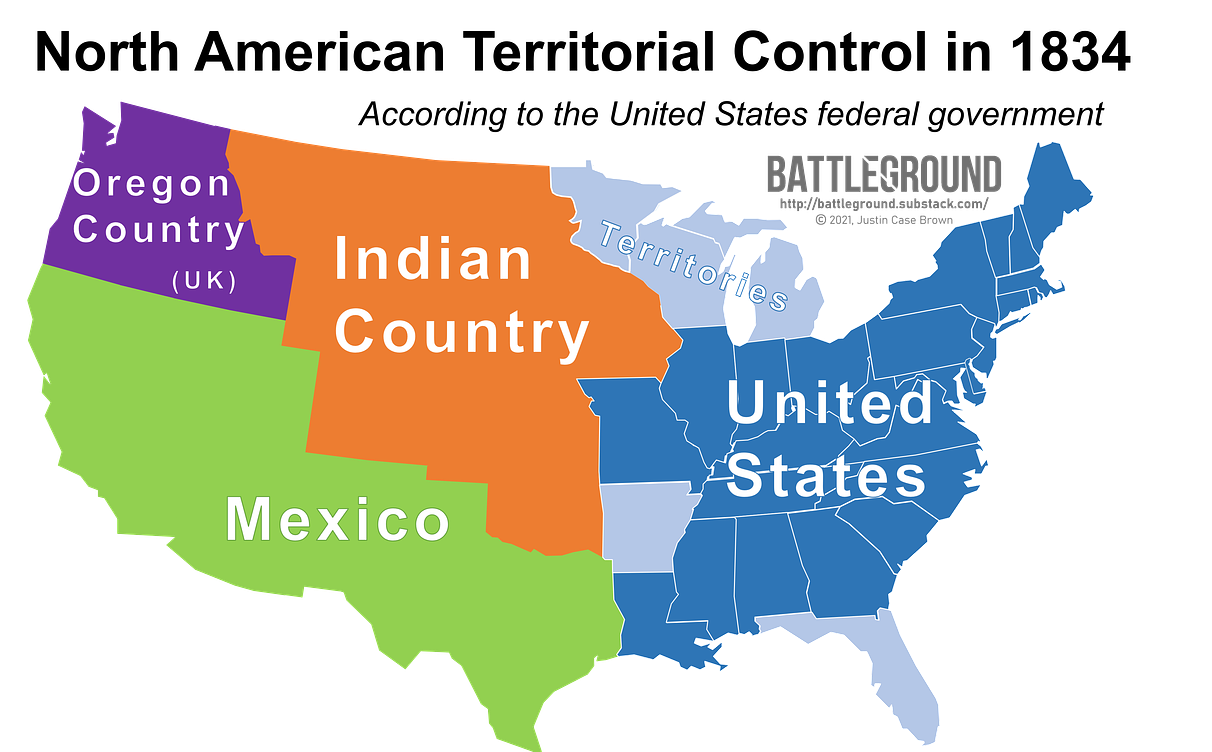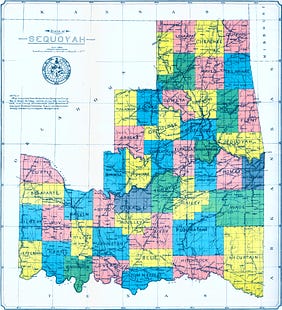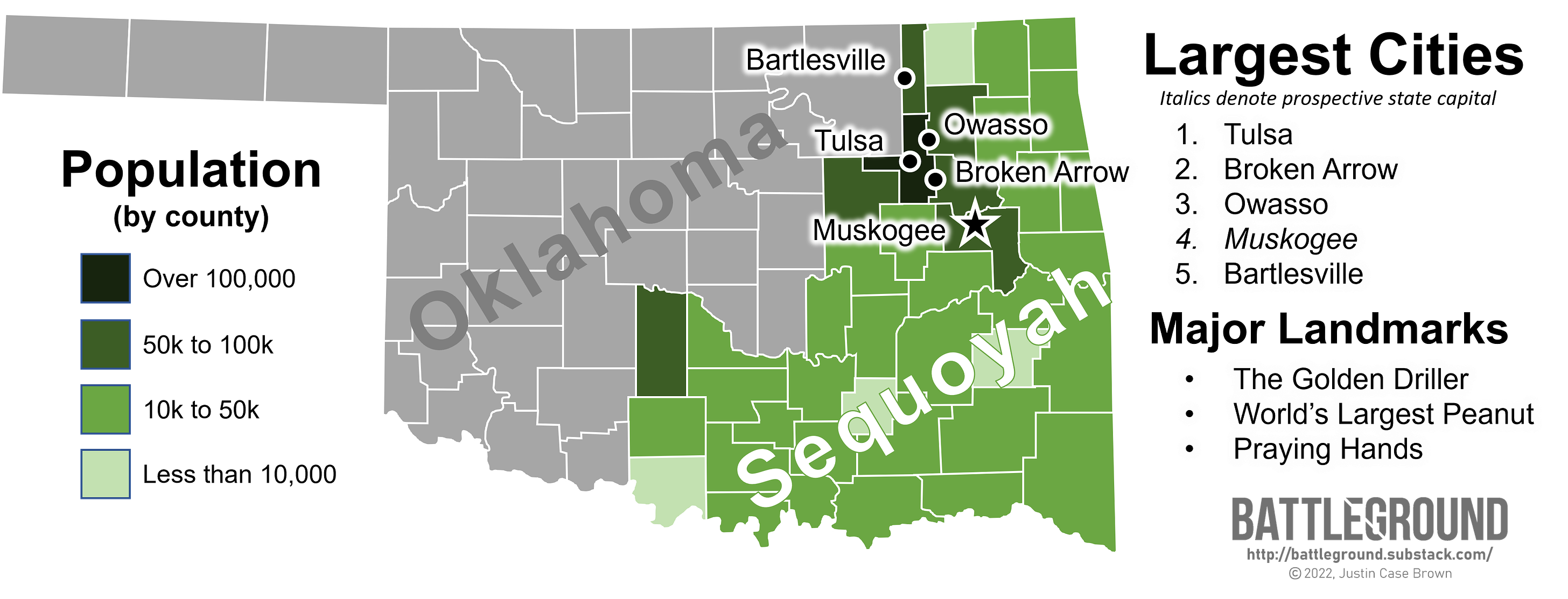Battleground - Sequoyah: The Native American State
Sequoyah: The Native American StateA statehood movement borne out of forced relocation and removal.
Hey Everyone! This week, I’m partnering with a new product called Waxbite. Waxbite, gives your inbox a voice by creating an audio version of your favorite newsletters. Stay up to date, informed & entertained all without reading a word! Every send from Battleground this week will be featured as a Guest Issue on waxbite. Sign Up and start listening today! FYI: A few of you may recognize that today’s post is a repost of old content. I figured I’d lift up this piece since my readership has doubled since this was originally posted in October 2021. Statehood HistoryMaps that identified “Indian Country” during the 19th century failed to show the true extent of Native American settlement. Instead these boundaries marked land set aside by the United States government for forced resettlement of indigenous peoples. The territory’s boundaries, set forth in the Non-Intercourse Act of 1834, were defined as “all [parts] of the United States west of the Mississippi and not within the states of Missouri and Louisiana, or the territory of Arkansas.” In conjunction with the Indian Removal Act of 1830, many Native American tribes were forced off of their ancestral lands east of the Mississippi river. While some removals were peaceful, hinging on transfers of land through the signing of treaties, many removals were violent and deadly. (The Second Seminole War was fought due to the Seminole tribe of present-day Florida resisting forced relocation.) This practice of forced relocation is what led to the Trail of Tears, an event many scholars view as genocide. During the brutal journey west thousands of indigenous peoples died due to starvation and disease, ultimately thinning out the country’s Native American population. Those lucky enough to survive the long journey primarily settled in present-day eastern Oklahoma on large swaths of land designated for indigenous resettlement. While this forced relocation was taking place, the area previously known as “Indian Country” was shrinking incredibly quickly due to the establishment of new states and territories. The passage of the Kansas-Nebraska Act of 1854 created both Kansas and Nebraska Territories and reduced “Indian Country” to “Indian Territory” which fell completely within the confines of present-day Oklahoma. The history of the State of Sequoyah officially begins with the passage of the Curtis Act of 1898. The law abolished all tribal governments within the United States and established individual land holdings on lands previously set aside for Native Americans. An estimated 90 million acres of land were removed from Native American control with the passage of this law. It was quickly followed by the Oklahoma Organic Act of 1890 which established the previously “unorganized Indian Territory” as two incorporated territories of the United States: Oklahoma Territory and Indian Territory. Much like the Curtis Act of 1898, this law continued the process of dissolving Native American tribal structures in anticipation of admitting the two territories as a single US state. Throughout history, these tribes largely resisted US statehood and sought self-governance on their own terms. As the federal government refused to recognize these tribal governments at the turn of the century, Indigenous peoples in the newly organized Indian Territory began to consider statehood as a viable option for continued self-determination. The Sequoyah Constitutional Convention was held on August 21, 1905 in Muskogee, the prospective state’s would-be capital. The Convention resulted in a 35,000-word constitution to govern the new state, a map showing the counties to be incorporated and an elected delegation to represent the new state in Congress. The convention’s proposals were put to a referendum later that year in November and was overwhelmingly supported by the territory’s voters. Unfortunately, the statehood proposal did not receive a warm welcome when introduced to Congress. Despite Native Americans’ display of ‘civility’ (🙄) through the organization of a rigorous constitutional convention, many White congressman bristled at the thought of an official state governed by and for Indigenous peoples. Others were concerned with the explicitly political ramifications of admitting a new Democratic-leaning state. At the time, Congress was controlled by Republicans who were reluctant to cede their control to the opposing party through the introduction of new Democratic lawmakers. As a result, President Theodore Roosevelt (a Republican himself) stood against the State of Sequoyah and instead recommended merging these lands with the more heavily White Oklahoma Territory directly to the west.
Sequoyah TodayToday, roughly 13 percent of Oklahoma’s total population identifies as Native American and the state has the second highest number of Indigenous peoples of any state in the US. Much of these residents live in “Sequoyah” as many of these eastern counties hold significantly higher proportions of Native Americans than those in the western reaches of the state. While the Sequoyah statehood movement died out shortly after the merger of the two territories into the singular state of Oklahoma, its legacy lives on in the Oklahoma Constitution. Much of that constitution incorporated proposals from the Sequoyah Constitutional Convention. While the prospect of Sequoyah statehood in the future is highly unlikely, the Supreme Court recently gave an unexpected nod to the failed state. In July 2020, the Supreme Court ruled that much of Oklahoma still lies within a Native American reservation. In McGirt v. Oklahoma, the court found that reservations predating the Oklahoma Enabling Act of 1906 were never disestablished by the federal government. As a result, any crimes committed in these areas are under the jurisdiction of tribal courts rather than Oklahoma courts. While the court case has clear real-world implications, many also view the case as a symbolic win for Native Americans. Justice Neil Gorsuch acknowledged in the majority opinion that the United States should keep promises made to Native Americans despite the country’s long history of breaking written promises. While the ruling doesn’t give Native Americans the self-determination they sought more than 100 years ago, it does signal that today’s federal government is beginning to reckon with its long and ugly history of racism toward Indigenous peoples.
A gift for me is a gift for you! Supporting Battleground unlocks paywalled content, feel free to Buy Me A Coffee or send to $battlegroundmaps via Cash app. |
Older messages
Connecticut: A Single 'Special Master' Draws Districts... Again
Thursday, March 17, 2022
For the second decade in a row, Nathaniel Persily draws the contours of Connecticut's congressional boundaries.
Rhode Island: The "Trump Line" Persists
Tuesday, March 15, 2022
Rhode Island's true blue hue is being threatened by inland Republican voters in RI-02.
Maine: Cooperation Leads to Competition
Monday, March 14, 2022
Maine's unique political landscape places this remote state at the center of attention during election season.
Westsylvania: The Fourteenth Colony
Friday, March 11, 2022
Colonialism, tax evasion and a whole lot of bourbon whiskey.
☕ Here's what your donations paid for last month... ☕
Thursday, March 10, 2022
Battleground is powered by caffeine, supported by readers like you.
You Might Also Like
☕ Bay watch
Wednesday, March 5, 2025
Inside Bay FC's second NWSL season brand campaign. March 05, 2025 View Online | Sign Up Marketing Brew Presented By Canva It's Wednesday. Kraft Heinz is rolling out a line of Crystal Light-
☕ eTail as old as time
Wednesday, March 5, 2025
Our takeaways from eTail Palm Springs. March 05, 2025 View Online | Sign Up Retail Brew Presented By Hightouch Hey there. Trump's tariffs are igniting a trade war, Target's ticking up its
Trump's address to Congress.
Wednesday, March 5, 2025
The president addressed Congress for the first time in his second term. Trump's address to Congress. The president addressed Congress for the first time in his second term. By Isaac Saul • 5 Mar
Ape Tree
Wednesday, March 5, 2025
Writing of lasting value Ape Tree By Uri Bram & Peter Hirsch • 5 Mar 2025 View in browser View in browser Self-Domesticated Ape Kevin Kelly | Technium | 2nd March 2025 The first animals
📬 No. 69 | How to (properly) monetize your newsletter with ads
Wednesday, March 5, 2025
From ad rates to formats to data, here's what you need to know. ͏ ͏ ͏ ͏ ͏ ͏ ͏ ͏ ͏ ͏ ͏ ͏ ͏ ͏ ͏ ͏ ͏ ͏ ͏ ͏ ͏ ͏ ͏ ͏ ͏ ͏ ͏ ͏ ͏ ͏ ͏ ͏ ͏ ͏
💥 ‘Daredevil: Born Again’ Is A Fearless Revival
Wednesday, March 5, 2025
Plus: Vin Diesel wants to make a weird 'Guardians of the Galaxy' spinoff. Inverse Daily The Disney+ reboot of 'Daredevil' overcomes an early identity crisis to bring back the best parts
Trump speech evokes kinglike president founders feared
Wednesday, March 5, 2025
+ ethics of Marvel's MCU
The Eyeliners We Can’t Stop Buying
Wednesday, March 5, 2025
Including a multistick that doubles as a lip and cheek color. The Strategist Beauty Brief March 05, 2025 Every product is independently selected by editors. If you buy something through our links, New
Numlock News: March 5, 2025 • Bladderwrack, Iceberg, Vapes,
Wednesday, March 5, 2025
By Walt Hickey ͏ ͏ ͏ ͏ ͏ ͏ ͏ ͏ ͏ ͏ ͏ ͏ ͏ ͏ ͏ ͏ ͏ ͏ ͏ ͏ ͏ ͏ ͏ ͏ ͏ ͏ ͏ ͏ ͏ ͏ ͏ ͏ ͏ ͏ ͏ ͏ ͏ ͏ ͏ ͏ ͏ ͏ ͏ ͏ ͏ ͏ ͏ ͏ ͏ ͏ ͏ ͏ ͏ ͏ ͏ ͏ ͏ ͏ ͏ ͏ ͏ ͏ ͏ ͏ ͏ ͏ ͏ ͏ ͏ ͏ ͏ ͏ ͏ ͏ ͏ ͏ ͏ ͏ ͏ ͏ ͏ ͏ ͏ ͏ ͏ ͏ ͏ ͏ ͏ ͏ ͏ ͏ ͏
☕ More than meeting notes
Wednesday, March 5, 2025
How Gecko Robotics knew it needed AI. March 05, 2025 View Online | Sign Up Tech Brew Presented By JumpCloud It's Wednesday. We don't want AI to help us write—we can do that just fine. But AI



